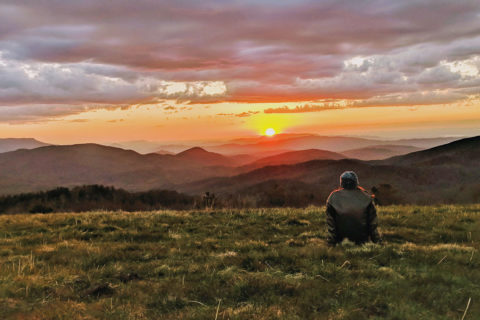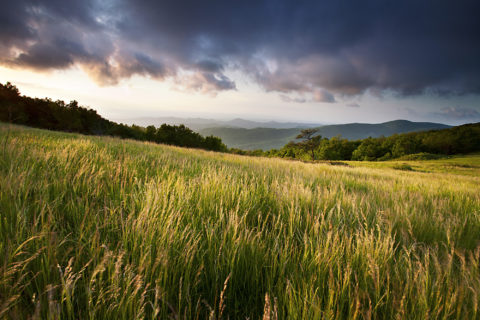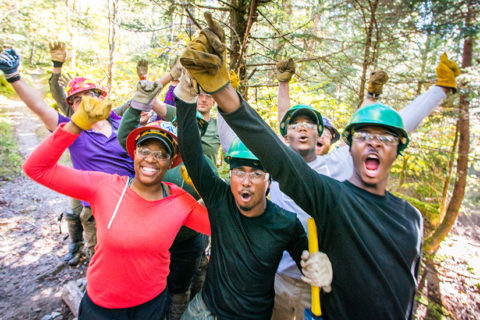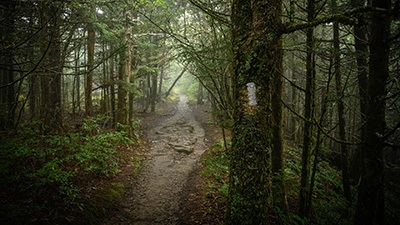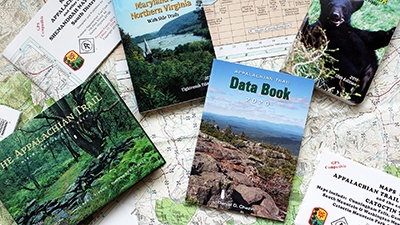Love Stories from the Trail
A.T. the Heart
March 11, 2022
Everyone’s connection to the Appalachian Trail has its own powerful back story. These love stories are as unique and eclectic as the vast A.T. landscape. And some become beacons of inspiration for many others. Stories of healing, community, care, education, people, and place. These relationships are the ties that bind Trail to heart and build hope for a bright future.
Ward Cammack
Healing
How the A.T. has shaped me is that of a perfect, long meditation, learning that listening and questions are what life is about.
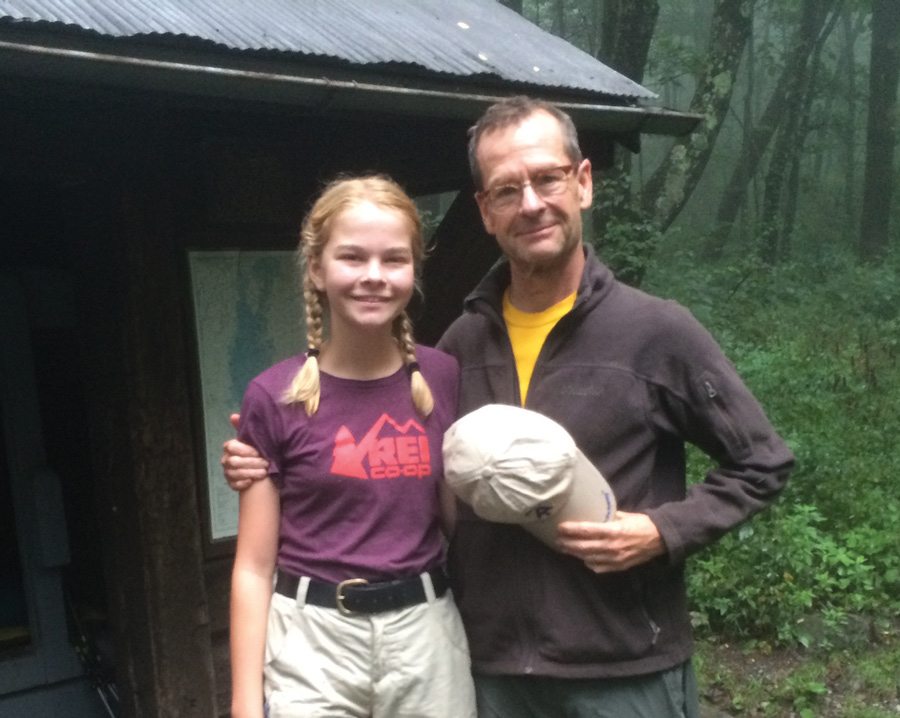
Ward with his other daughter, Ward, during a hike from Rockfish Gap to Harpers Ferry.
How do you find a way forward when what you love most is suddenly taken away? In 2013, Ward Cammack’s 23-year-old daughter Martha died of natural causes in her sleep. Struck with grief, Ward turned to the Appalachian Trail to seek the sort of solace and therapy only nature provides. In his words:
“Bereft, and wanting to feel the love and connection of the universe brought me to the Trail for healing. It was an opportunity to let my thoughts stretch out, think about our loss, and try to come to terms in some way.”
The idea of the A.T. being a therapeutic space and experience is not new. Earl Shaffer turned to the Trail, completing the Trail’s first-recorded thru-hike, to “walk off the war” or, as we know it now, cope with the post-traumatic stress disorder (PTSD) he experienced during World War II. While each person’s connection to the Trail and experience is unique, Ward captured what the Trail meant to him after his daughter’s death:
“The A.T. is sacred, evolved of matter, space, and souls. A mysticism of thin-space, aloneness, connectivity, rigor, and wonder . . . . I wanted that.”
Turning to the A.T. and finding myriad values and benefits — emotional, psychological, and physical — was the first step to Ward’s long-term relationship with the Trail.
“I’m 65 and first hiked a section of the A.T. with my wife in 1998. Since my initial journey, I have hiked almost half the total distance of the A.T. in various sections in Maine, Tennessee, North Carolina, Georgia, and Virginia. I usually hike in May and June, and my favorite section is the Roan Highlands. It has shaped me as living within the Trail, meeting so many different people and listening to their stories – Buddhist monks, war vets, people from so many other nations, hikers needing help, those helping others, those seeking the perfect Trail diet and so on. How it has shaped me is that of a perfect, long meditation, learning that listening and questions are what life is about.”
Neville Harris
Community
Love is the community that hikes. Hope is the Trail volunteer, the Trail Angel, the ATC, and Joy is the result.

Neville on the porch of Woods Hole Hostel.
Woods Hole Hostel is legendary. Most Appalachian Trail long-distance hikers who pass through southwestern Virginia will happily identify an overnight stay at Woods Hole as a highlight of their journey. Not only is the hostel a beautiful, warm, and inviting space, but its owner — Neville Harris — reflects these qualities herself.
Neville owns and operates the Pearisburg, Virginia hostel following in the footsteps of her grandparents Roy and Tillie Wood. The Woods first found the cabin in 1939, lived in it, eventually purchased it along with 100 adjacent acres, rented it out to hunters for over 40 years, and then opened it as a hostel in 1986. Neville’s memories remain strong:
“I was four the first time I visited. My love of the Trail was nurtured through watching the community. When I was young, I don’t remember hikers making an impression upon me. I just remember them being at the breakfast table. I remember them being fascinated by my grandmother and the stories she shared about her and my grandfather’s own connection with nature. In their twenties, my grandparents had lived at the cabin for one year without electricity and running water. I think hikers were inspired and moved by this story along with many others she shared.
“It wasn’t until I was in my twenties that I fell in love, not with the hikers, but with this place. I saw my own healing happening deep in the woods. The nurture that nature provided. Of course, I loved the hikers. They were all so kind and grateful. But, it was this place that ultimately attracted me to the Trail.”
Neville’s grandfather passed away in 1987, and her grandmother continued to run the hostel until her death in 2007. It was at that point that her mother asked if she wanted to live in the cabin and operate Woods Hole. “The Trail became a vehicle for my personal growth when I began serving the hiker community in 2009. My relationship to the A.T. is a connection.”
“The Trail is not the Appalachian Trail Conservancy (ATC), the Trail maintainer, the hiker, the Trail angel, or the forest. It’s the combination of all these entities and more. I feel blessed and lucky to have my small part along this path. I read a quote the other day: ‘Faith is the seed, love is the power, hope is the sun, and joy is the flower.’ Faith is that the Trail will always be here. Love is the community that hikes. Hope is the Trail volunteer, the Trail angel, and the ATC, and joy is the result.”
That joy has been reflected many times in the experiences of many hikers who have found, in Woods Hole and in Neville, a reflection of the spirit of the Trail itself.
Marianne Skeen
Care and Education
My attraction to the A.T. is about the people and the quality of the volunteer experience.
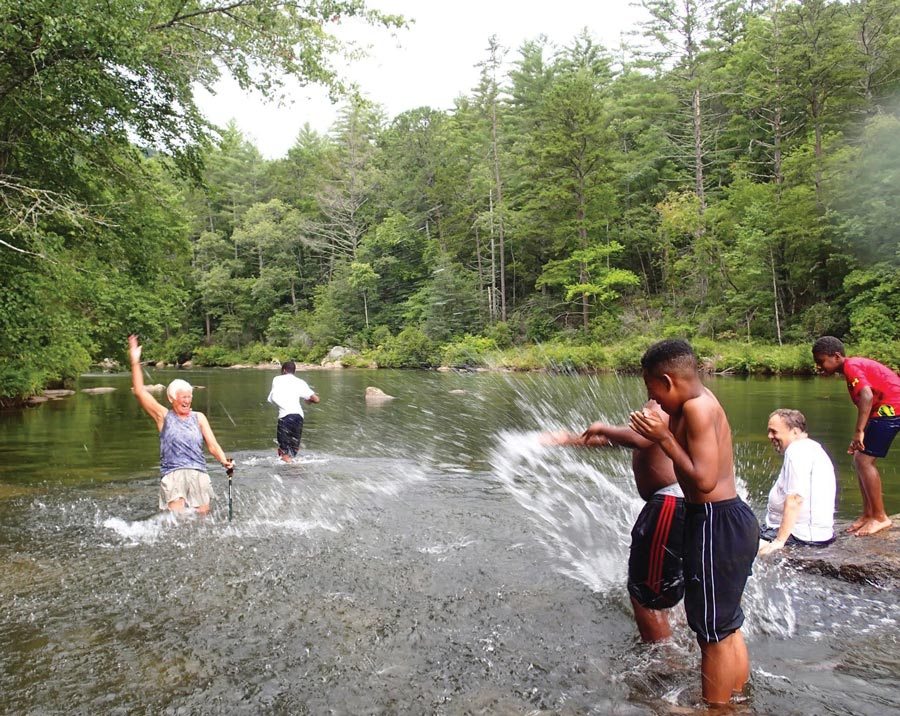
Marianne (far left) enjoys the Chattooga River with the group during a GATC outreach backpacking and camping trip.
For most, hiking the Appalachian Trail is an expression of love — for the experience, for nature, and for the feeling one gets immersed in the green tunnel that stretches seemingly forever. Far fewer find love in caring for the Trail itself.
Marianne Skeen’s love language is Trail stewardship. She loves hiking the A.T. and being outside, but she is also passionate about developing the next generation of Trail stewards and maintaining her section of Trail. As Marianne says:
“My attraction to the A.T. is about the people and the quality of the volunteer experience. My best friends are the people I hike with, and they have encouraged me to try adventures I might not have otherwise, including more vigorous hiking and international trekking. It is also the continued relationships with the Appalachian Trail Conservancy(ATC) staff, A.T. hikers, Trail volunteers, government employees, all who share a common interest in the Trail. My volunteer experiences with the ATC have been well organized and high quality, which is not always the case when giving of your time. There are so many ways you can do things for the A.T.”
Marianne, now 77, has lived this credo. Her involvement with the Georgia Appalachian Trail Club (GATC) has spanned 43 years, in roles as diverse as the club’s president, Trail supervisor, and lead for the GATC’s Forest Plan Revision Committee for Chattahoochee National Forest. She served as chair of the 1993 ATC Conference in Dahlonega, Georgia, and twelve years on the ATC Board of Managers starting that year.
She has also worked tirelessly to develop the next generation of Trail maintainers. Helping introduce inner-city children to the outdoors through the GATC Outreach Program — which emphasizes Leave No Trace ethics and is a program that has now spread to many community schools in the Appalachian Mountains — will surely have a lasting impact in the region and a lasting impact on the Trail that Marianne and millions of others love.
As Marianne, and thousands of volunteers have shown caring is not only a way to express love for the Trail but a way to make sure it’s there for others to love in turn.
Bob Peoples
People and Place
My love of the backcountry and the Trail all comes down to the people.
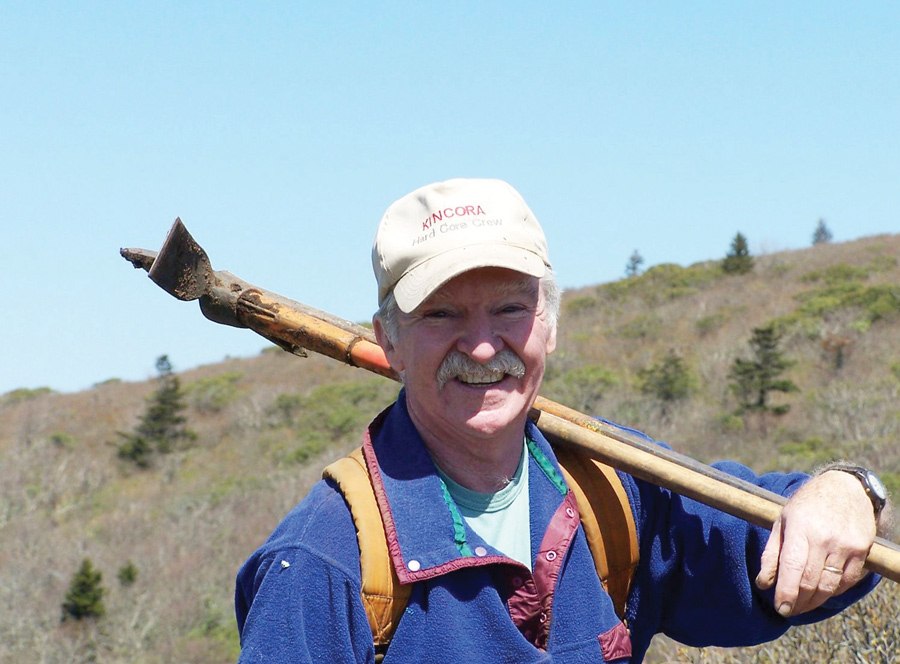
Bob during a Hard Core Trail Crew work trip.
“Bears hang Bob Peoples’ food bag for him.”
“When Bob Peoples builds a switchback, an angel gets its wings.”
Those are just some of the legendary epithets concocted to honor Bob Peoples. While the epithets may be hyperbolic, it’s undeniable that Bob is an Appalachian Trail legend. He and his late wife Pat opened Kincora Hikers’ Hostel in Hampton, Tennessee, in 1997 and have hosted more than 25,000 hikers since.
In Bob’s words:
“I’m 77, and I retired from the Air Force, where I worked in aircraft maintenance. We settled in Vermont, and my interest in hiking grew from time spent on the Long Trail near my home. We were in search of land close to the Trail to open a hostel, which eventually led us to Hampton and Kincora.”
But, Bob’s contributions to the A.T. extend far beyond hosting the thousands of hikers who pass through Kincora. He has completed more than 11,000 hours of Trail maintenance with the Tennessee Eastman Hiking and Canoeing Club. “I do Trail maintenance because it is pay back. Someone built trails for us. I’m working to make it better for the next hikers. To help reduce overuse at places like Max Patch and Carvers Gap, I am also assisting the Eastern Tennessee Trail Club to build new trails for people to explore.”
Working with the Hard Core Trail Crew, he also helped introduce hikers to Trail maintenance. “This was started by the Eastman Hiking Club in 2000 and thru-hikers sign up at Trail Days in Damascus each May to work on the Trail for a couple days. The volunteers have helped build, relocate, refurbish, and repair the Trail, as well as build bog bridges and a shelter.”
It’s not surprising, though, to learn that Bob’s love of the Trail extends beyond the place and is squarely devoted to the people of the A.T.
“My love of the backcountry and the Trail all comes down to the people. In the backcountry, people will go so far out of their way to help you. It is the same all over the world. It really reestablishes your faith in mankind. People are not so wound up with stress and they have slowed down. Being on the Trail gets people away from their phones and computers, giving them time to think, reflect, and get their mind back. You realize the things you thought were important are really not.”
It’s clear that Bob has not only found what’s important to him, but his love and care of the Trail and its community is the stuff legends are made of.
This article was first published in our Winter 2022 issue of A.T. Journeys, the official membership magazine of the Appalachian Trail Conservancy.
Discover More

BY SANDI MARRA, PRESIDENT & CEO OF THE ATC
A Love Letter to the Trail
ATC President & CEO Sandra Marra discusses how the relationship with her husband, Chris, was nurtured on and by the Appalachian Trail.
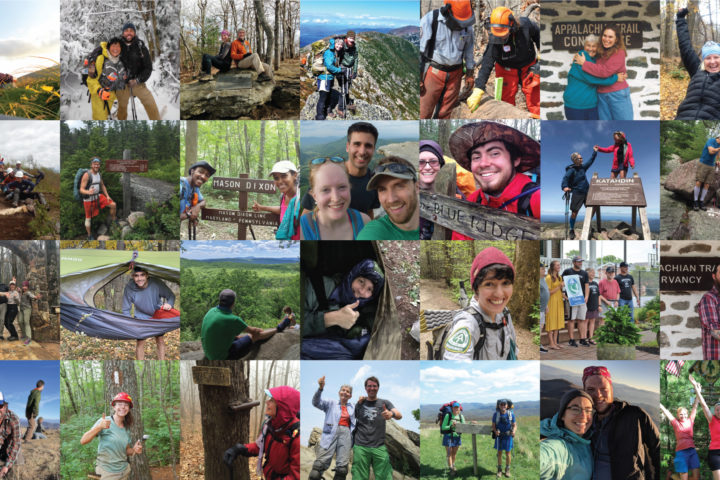
Stories from the Trail
Love Letters to the A.T.
Read stories from the A.T. community about what made people fall in love with the Trail and what keeps that love going strong today.
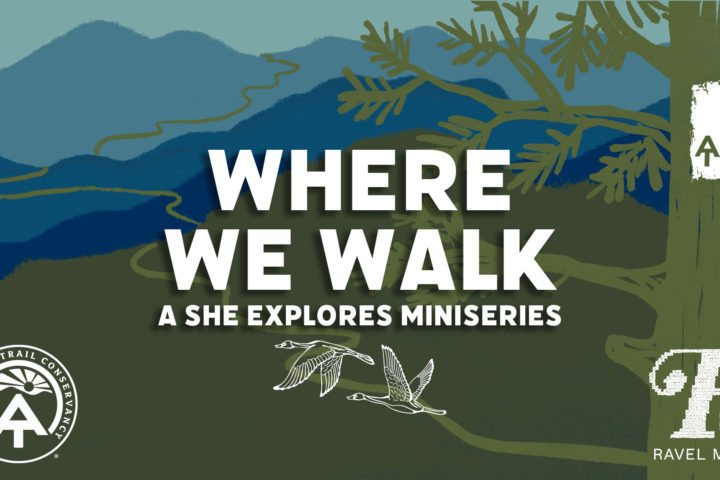
Listen Now
“Where We Walk” Podcast
This six-part podcast miniseries explores the women who have helped make the Trail what it is today, as well as those who are shaping its future.

